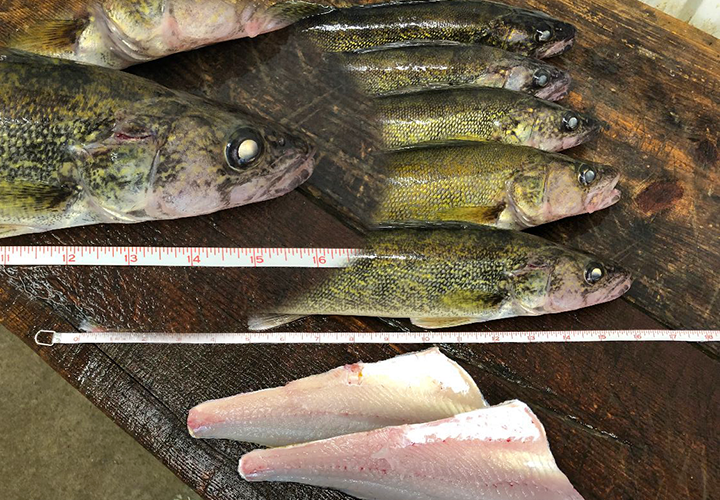About a year ago, retired DNR Big Lake Specialist and our friend, Gerry Albert, mentioned this in a casual conversation; “because of Lake Winnie’s rapid growth rate, walleyes from the 2018 will grow fast. Once they reach maturity, it won’t be much more than a couple of seasons before fish of that age will begin entering the protected slot, 18 to 23 inches.”
Lake Winnie “Class of 2018” Walleyes
Fish from that large year class have entered what we consider an “ideal size range”, 15 to 16 inches and are on the prowl in the big lake. As the accompanying photo shows, anglers who figure out where to look can gather a meal of fish from abundant supply of 2018 year class fish.
So, where do they look, you may be thinking? The simple answer is by staying away from the crowds and away from wherever the “bite chasers” have proclaimed as the “best” fishing spots.
Walleyes from the massive 2019-year class, and even some of the tiny 2020-year class fish now dominate the action in certain areas on Winnibigoshish. In some spots and when conditions are prime, catching doubles, even triples have been common, anglers have enjoyed a lot of action catching the 2019 class, 12-1/2 to 13-3/4 -inch fish. Some anglers are happily harvesting fish from the higher end of that year class already
While it is true that anglers will harvest some larger size fish amidst the legions of smaller ones, most of the fish will be cookie cutter cousins from 2019, sticking together in huge schools. Even when there are larger fish present, they face extreme competition from the hungry little guys who will race them to your lure and most often, win.
Curt Black showing of a nice Winnie Walleye caught on “offbeat structure”.
Leaving the “hot bite” in search of smaller schools, of larger fish, can pay off big time because those fish, ones from the 2018-year class are both abundant and feeding, but often located on smaller, more isolated structures.
By searching out the smaller, more off-beat spots, not only will your catch more harvestable fish, but your chances of catching larger size, photo fish will go up too.
Shoreline related points, rock and gravel patches on the flats and small, more isolated patches of vegetation are all good places to look. Often, the spots are small, so food sources are more limited, enough to support small groups of fish, but not massive ones. The food sources may also be different, walleyes here may be feeding on “adult” perch rather than tiny, minnow size ones. Crawfish, larger minnows and even insect larvae can add to the attracting power of these spots.
Key water depths are 10 to 12 feet, somewhat deeper than the shallow shoreline areas that have been providing the hot action recently. But, don’t overlook shallower water either, there are isolated structures there too and they will also hold smaller schools from the strong 2018 year class.
Jig and minnow presentations now make up the lion’s share of anglers’ offerings. While there are a handful of anglers trolling spinners or crankbaits, their numbers are declining by the day.
A handful of jigs in the 1/16, 1/8 and ¼ ounce sizes will cover you for most situations. Tipping them with larger minnows, ones in the 3-to-4-inch range will increase your chances of success. Fatheads, golden shiners, spottails, rainbows and “river mix” minnows will all produce good results. Just remember that fall is feeding time for these fish and the best fish, want the best food, so avoid any minnow species when they are too small.
Perch, many of quality size are on the prowl these days too! Vegetation over shallow flats is the structure to look for. Massive schools of baitfish, along with schools of small young of the year gamefish dominate the food sources, but there are perch feeding on insects and crawfish too. So be on the lookout for gravel patches that lay adjacent to vegetation, these will be “premium” perch locations.
Small, 1/16-ounce jigs tipped with medium fatheads are perfect. When there are strong winds, switch over to 1/8-ounce jigs to help maintain better contact with your lure to improve your sense of feel.
Panfish, particularly crappies, have taken a back seat to the walleyes this fall. Aficionados though, are sneaking around and finding them in both shallow weed growth and “classic fall spots” over deeper, open water.
Without a lot of firsthand information coming in, its hard to offer solid advice for crappie anglers. So, let’s just say that if crappies are your passion and you spend some time prowling around, you will likely find enough of them to keep you satisfied.
Image of Bowen Lodge facing Lake Winnie October 3, 2021
With surface temperatures still holding steady in the middle 60s, classic fall migrations into Cutfoot Sioux have been slow to start. According to the calendar, our fishing season should be winding down now. But according to the weather, we could easily imagine seeing anglers on the lake for a couple more weeks as more fish begin to migrate in from the big lake.



